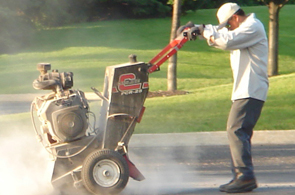Process
We route all cracks before sealing with a specialized routing machine that will cut a 3/4” x 3/4” channel into the crack of the pavement. Next, all cracks are blown clean. Once the cracks are clean, we inject the sealer through a heated hose from one of our two Oil Jacketed Melter/Applicator machines that keep the product at a constant temperature of 350-375° Fahrenheit.
By routing the crack first and injecting the sealer into the routed reservoir, the sealant reaches the bottom to the top of the crack allowing the sealant to expand and contract through weather cycles — protecting the integrity of the crack repair.
If a crack is not routed, the sealer cannot penetrate the depths of the void. Instead, the sealer dissolves into the crack from the top to the bottom, leaving a crack at risk for future repairs. The most expensive part of cracksealing is sealing the same crack again.
Finally, all crackseal material is overbanded on top of the crack with a 2”-3” wide band of material. This method provides the longest lasting crack repair and helps limit crackseal material from being scraped off by snowplows during the winter months.
Key Point: Cracks that are routed prior to being sealed last up to 50% longer. The long-term benefits that come from extending the life of the sealer more than offset the minimal costs associated with routing.
Product
RAPCO uses a federal specified Crack Sealant that meets ASTM 3405 D6690 Type II and III. This sealant is specified for Roadways and outperforms Parking Lot grade Crack Sealant material at higher and lower temperatures.





